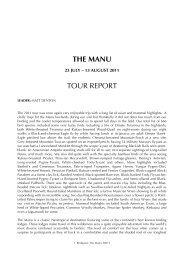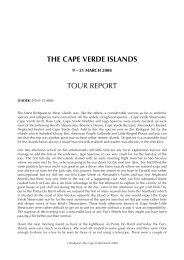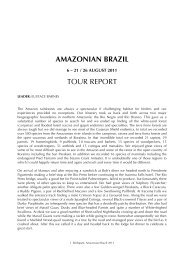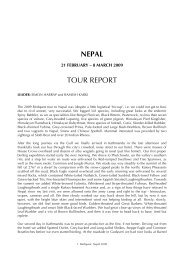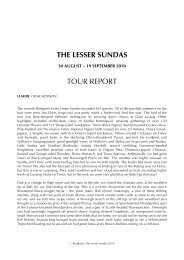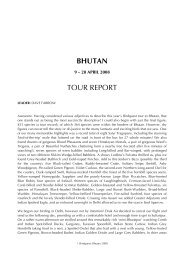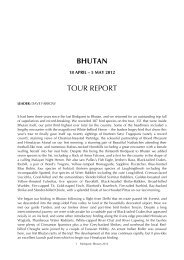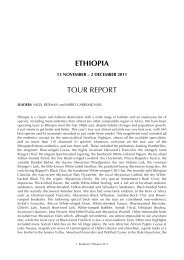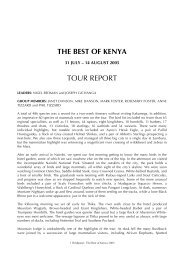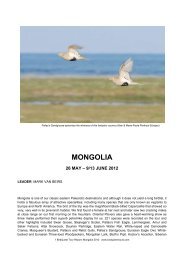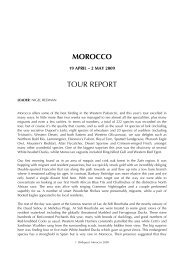SPITSBERGEN TOUR REPORT - Birdquest
SPITSBERGEN TOUR REPORT - Birdquest
SPITSBERGEN TOUR REPORT - Birdquest
You also want an ePaper? Increase the reach of your titles
YUMPU automatically turns print PDFs into web optimized ePapers that Google loves.
LEADER: MARK VAN BEIRS<br />
<strong>SPITSBERGEN</strong><br />
<strong>TOUR</strong> 1<br />
21 – 29 JUNE 2007<br />
<strong>TOUR</strong> <strong>REPORT</strong><br />
Svalbard holds some of Europe’s most fabulous scenery and some of its most spectacular wildlife and<br />
on our week’s cruise along the shores of the northern regions of this archipelago we got more than<br />
our share of what was on offer. The M/V Professor Multanovskiy took us to glorious glaciers, snowclad<br />
mountains, colourful patches of tundra and stretches of endless pack and drift ice. We were very<br />
fortunate with the weather, enjoying very calm conditions and plenty of sunshine, but we were<br />
thwarted on a couple of days by dense fog. The eight landings and four zodiac cruises all went<br />
smoothly, and gave us plenty of time ashore to enjoy the wildlife and surprisingly rich flora. Our final<br />
tally of 31 species of birds and nine species of mammals reflects quality instead of quantity and we<br />
observed a superb variety of splendid creatures like Polar Bear, Ivory Gull, Walrus, Beluga, Northern<br />
Minke Whale, Humpback Whale, King Eider, a nice assortment of breeding waders, including Red<br />
Phalarope, and, of course, huge numbers of breeding seabirds, notably Brünnich’s Guillemots and<br />
adorable Little Auks.<br />
Most of the large group of <strong>Birdquest</strong>ers – no fewer than 27 - gathered in Oslo, the capital of Norway,<br />
but the tour really started in earnest upon arrival at Longyearbyen, the main town of the arctic<br />
archipelago of Spitsbergen, although the spectacular scenery in northern Norway and the rather<br />
dramatic approach to the airfield in Tromsø were also much appreciated. Upon arrival at<br />
Longyearbyen we were welcomed by Rolf, one of the expedition crew from Oceanwide Expeditions,<br />
and within minutes we had piled into a bus and were driving away, first to drop off our baggage at<br />
the ship and then to visit ‘downtown’ Longyearbyen, the much bigger than expected capital of<br />
Spitsbergen. We had some time to explore the town and its lovely museum and souvenir shops. We<br />
also visited the waterfront and the famous husky kennels, where Ivory Gulls were sadly absent, but<br />
we did enjoy the communal wolf-like howling of the huskies – excellent value – and admired the cart<br />
being drawn by a husky team. Close to the kennel we found quite a substantial Common Eider<br />
colony, which included a single female King Eider on her nest. Noisy Arctic Terns attacked us<br />
1 <strong>Birdquest</strong>: Spitsbergen 2007
fearlessly when we got too close to their nests and pretty little Snow Buntings were singing from the<br />
rooftops. Purple Sandpipers and Dunlin foraged along the shoreline, where we also found several<br />
cute Long-tailed Duck and a few Glaucous Gulls.<br />
In mid afternoon we boarded the M/V Professor Multanovskiy, our floating base for the next week,<br />
settled into our cabins and assembled in the bar for our first of many briefings by the Oceanwide<br />
Expeditions staff (Rolf, Elke, Rico and Charlie). At about 6 p.m., we weighed anchor and were off,<br />
cruising west out of the Isfjord amongst really spectacular snow-covered mountain scenery. Another<br />
briefing (this time on safety matters), the mandatory lifeboat drill and the excellent dinner, prepared<br />
by our New Zealand and Malaysian chefs, took up much of the evening. With 24 hours of daylight,<br />
there was still plenty of time for sea-watching from the decks as we moved out of the fjord into the<br />
open sea. Here, we familiarized ourselves with the commoner seabirds of Spitsbergen: Northern<br />
Fulmars, almost entirely of the dark ‘blue’ morph typical of high latitudes, dashing Arctic Skuas,<br />
dainty Black-legged Kittiwakes, and the four common auks, Brünnich’s Guillemot, Black Guillemot,<br />
Little Auk and Atlantic Puffin.<br />
Next morning, we were anchored off the little island of Blomstrandhalvøya, and after an interesting<br />
briefing on how to avoid being eaten by a Polar Bear and how to get in and out of a zodiac, we<br />
landed at this rich coastal tundra environment. Here, as at many of our landing sites, we split into<br />
three groups: a group of ‘amblers’ who could potter along slowly looking at the birds and plants, a<br />
group of ‘hikers’, who could head up the nearest mountain to enjoy the view and a group of very<br />
well equipped photographers, which we soon nicknamed, “the paparazzi”. The only restriction was<br />
that with each group there should be a guide armed with a rifle – just in case we would encounter an<br />
unfriendly Polar Bear. We had a look at the remains of an ill-fated marble mine plant, but the main<br />
attraction here was the resident pair of extremely elegant Long-tailed Skuas, that posed so very well<br />
for us. Rather shy Red-throated Divers inhabited the pond and a Pink-footed Goose had built its nest<br />
on top of a crag. Several pairs of Barnacle Geese were breeding on an islet and a cracking male Rock<br />
Ptarmigan was overlooking his territory from the top of a boulder. An excellent selection of colourful<br />
and interesting flowers like Purple Saxifrage, Arctic Bell Heather, Hairy Louseworth, Mountain Avens<br />
and the tiny Polar Willow were also much appreciated. Several Reindeer of the small and short<br />
legged Svalbard race were grazing nearby.<br />
In the afternoon we visited the interesting scientific community of Ny Ålesund, the northernmost<br />
village in the world, containing the northernmost shop and post office on our planet. Here, we<br />
learned about the exploits of Amundsen, Nobile and Ellsworth in their attempts to reach the North<br />
Pole by airship, and checked out the ponds, creeks and shoreline for birds. One of the highlights was<br />
the friendly female Arctic Fox with her seven adorable pups, but the splendid adult Ivory Gull in its<br />
immaculate white finery really stole the show. A pair of Common Ringed Plovers tried to lure us<br />
away from their nest and hordes of Little Auks were circling high over the nearby mountain which<br />
holds the northernmost cable car in the world. The rarest bird was found by Alan as he showed us a<br />
vagrant male Common Blackbird at the dog kennels. Probably the northernmost Common Blackbird<br />
ever !!<br />
After another scrumptious dinner we cruised into the Kongsfjord and ended the day by admiring the<br />
amazing Kongsvegen glacier at close range. The high and imposing ice cliff showed patches of<br />
different magical hues of blue and hundreds of Black-legged Kittiwakes and Northern Fulmars were<br />
bathing in the meltwater. Three Bearded Seals were loafing on the ice shoals.<br />
In midmorning we arrived in the huge Liefdefjord on the northern coast of the archipelago. The<br />
mirror-like sea reflected the spectacular surrounding snow-covered mountains, but as soon as we<br />
2 <strong>Birdquest</strong>: Spitsbergen 2007
oarded the zodiacs for a leisurely cruise amongst the Andøyane Islands (Duck Islands), mist started<br />
to form and spoiled it all a bit for us. We still saw three highly attractive drake King Eiders and then<br />
landed on a small island, where Rolf first checked the place out armed with his Remington rifle.<br />
Another male King Eider showed very well, but the main attraction were the seven dainty and<br />
colourful Red Phalaropes doing their thing at close range. Great fun. We also did our bit for<br />
conservation as we collected lots of plastic and disused fishing nets. Later we sailed further into the<br />
Liefdefjord, where we eventually ground to a halt in the ice about 3 km from the Monaco glacier, one<br />
of the largest in Spitsbergen, and here, in a truly magnificent setting we observed at least eight<br />
different, striking and much-prized Ivory Gulls. After dinner, we anchored in the nearby Bockfjord,<br />
where our only Pale-bellied Brent Geese of the trip were seen and where we walked to the tiny<br />
thermal pool, which is one of the few remains of volcanic activity on Spitsbergen. Here, we obtained<br />
perfect scope views of a male and an unobtrusive female Rock Ptarmigan. In the late evening we<br />
sailed out of the Woodfjord escorted by skeins of hundreds of Little Auks and Brünnich’s Guillemots<br />
and close to midnight John found a rather distant pod of Belugas, that some of us still managed to<br />
see.<br />
The next day we arrived at the Alkefjellet (Auk cliffs) in the Hinlopen Strait and in mid morning we<br />
made a very much appreciated zodiac cruise below the up to 100m high cliffs which harbour about<br />
50,000 pairs of Brünnich’s Guillemots. The sea was full of these very arctic alcids and so were the<br />
cliffs, where we enjoyed intimate scenes amongst these feisty creatures. Most of the birds were<br />
brooding and several pairs of Glaucous Gulls kept an eye on things and obviously lived off the<br />
colony. There were also good numbers of Black Guillemots and Black-legged Kittiwakes about.<br />
Whilst returning to the ship our zodiac spotted a swimming Walrus. Most of the rest of the day we<br />
cruised amongst the drift ice of the central part of the Hinlopen Strait, where the mirror-like surface<br />
was partially covered with small icebergs in an immense variety of shapes. We had great looks at a<br />
docile Bearded Seal and spotted a couple of Northern Minke Whales. In the early evening we made a<br />
landing at the Sorgfjord where we found several Sanderling in breeding plumage and a few<br />
displaying Purple Sandpipers and heard fascinating bits of local history at the bleak cemetery.<br />
In the early morning the M/V Multanovskiy had reached its northernmost position at 80°48’ North at<br />
the edge of the pack ice to the west of the Sjuøyane Islands. After another excellent breakfast we<br />
were all on deck and started sailing slowly along the edge of the ice that stretched north to the pole.<br />
Within minutes our party had found the main target of the tour: a formidable Polar Bear and Captain<br />
Igor Stetsun then tried to follow this magnificent creature amongst the large ice floes of this<br />
incredibly hostile environment. He remained rather distant but we were immensely happy and felt<br />
privileged. Later in the day another Polar Bear was spotted at much closer range and this one stunned<br />
us all by coming towards the ship and allowing fantastic views while swimming and inspecting us.<br />
When it finally realized we were a bit out of his league, he walked away over the pack ice. The King<br />
of the High Arctic had obliged. While observing this glorious animal, another bear was found<br />
ambling in the distance. Our only Sabine’s Gull of the trip showed just as we were concentrating on<br />
the bear and we also observed a splendid fully-spooned Pomarine Skua. In the afternoon we boarded<br />
the zodiacs and just floated amongst the many ice floes and admired their incredible shapes and<br />
colours. The day ended with a delicious BBQ dinner cum glühwein on the foredeck. We had been<br />
warned to dress warmly. This was followed by some Russian dancing and later several <strong>Birdquest</strong>ers<br />
were invited to attend the birthday party of one of the crew members where they learned a few things<br />
about vodka…<br />
Early next morning found us just off Moffen Island, but sadly the mist was so dense that we could not<br />
even see the place and because Moffen is a strict nature reserve, we had to keep our distance. We<br />
hung around a bit and were rewarded with sightings of two swimming Walruses with impressive<br />
3 <strong>Birdquest</strong>: Spitsbergen 2007
tusks. We then sailed south to the northwest of the main island of Svalbard. The mist soon<br />
disappeared and dramatic scenery appeared all around us as we anchored just off the entrance of the<br />
Raudfjord. All five zodiacs were launched, and for the next couple of hours we explored the bay,<br />
admiring the huge colony of Black-legged Kittiwakes and Brünnich’s Guillemots on the precipitous<br />
cliffs, and drifting about amongst the bright blue icebergs in front of the 3km wide Hamilton glacier.<br />
In the afternoon we sailed to the nearby little island of Fuglesangen, where we enjoyed a delightful<br />
afternoon just sitting at the edge of an enormous Little Auk colony. These delightful little creatures<br />
soon settled down within very close range and posed so incredibly well. We had a great time here<br />
just lying amongst the boulders and watching these cuties display and cackle and fight and snooze.<br />
Magical moments. Every now and then a Glaucous Gull flew over the colony and startled all the<br />
Little Auks in taking flight, whereby they showed off their amazing flight prowess in spectacular<br />
dense Starling-like formations. But soon they settled down again, often within a few meters from us.<br />
This was definitely one of the highlights of the trip!<br />
On our last full day in Spitsbergen, we landed on Prins Karls Forland at a sandspit called<br />
Poolepynten, a haul out spot for male Walruses. A strategic approach under the watchful eye of our<br />
German expedition leader Rolf resulted in being able to approach these gentle-looking giants within<br />
50m. We spent a very enjoyable couple of hours watching and photographing the antics of these<br />
strange creatures that look like big fat slugs on land, but move so elegantly in the water. A<br />
spectacularly breaching Humpback Whale provided even more entertainment and so did another<br />
Beluga. Arctic Skuas were very much a feature of this area and once we saw no fewer than four birds<br />
chasing the same hapless Black-legged Kittiwake. Three Red-throated Divers were displaying, Red<br />
Phalaropes were spinning away and we also obtained our best views of several Great Skuas here. In<br />
the afternoon we explored a lovely tundra spot full of flowers called Eidembukta. The leisurely walk<br />
yielded a flock of c500 drake Common Eiders, about 15 King Eiders, a party of Long-tailed Duck<br />
including a male in winter plumage and several displaying Purple Sandpipers. We then sailed to<br />
Longyearbyen as several passengers had to catch a middle of the night flight out. After some final<br />
formalities on board, we said our farewells to our friendly crew and the Oceanwide Expeditions staff,<br />
and disembarked from the Professor Multanovskiy for the last time. A short bus ride brought us into<br />
town, and then those who did not want to spend the morning shopping ambled out to the husky<br />
kennels on the outskirts of town. Common Eiders, fierce Arctic Terns and Snow Buntings waved their<br />
goodbyes and we had lunch at the Café Busen. We then boarded our bus for the airport, and were on<br />
our way back to the hustle and bustle of the civilised world, filled with delightful memories and with<br />
full memory cards.<br />
4 <strong>Birdquest</strong>: Spitsbergen 2007
SYSTEMATIC LIST<br />
Species which were not personally recorded by the leader are indicated by the letters (NL).<br />
GAVIIDAE<br />
Red-throated Diver Gavia stellata: A fairly common breeding bird in Spitsbergen, where there are<br />
thought to be 500-1,000 breeding pairs. We saw them well on a number of occasions,<br />
including pairs on ponds or lakes at Blomstrandhalvøya, Ny Ålesund, the Andøyane<br />
Islands and on Prins Karls Forland.<br />
PROCELLARIIDAE<br />
Northern Fulmar Fulmarus glacialis: Common and ubiquitous at sea, often following the ship. There<br />
are thought to be between 500,000 and 1,000,000 pairs breeding in Spitsbergen. Most of<br />
the birds seen were of the dark morph, often known as ‘Blue Fulmar’ and characteristic of<br />
these high latitudes.<br />
ANATIDAE<br />
Pink-footed Goose Anser brachyrhynchus: A widespread breeding bird in Spitsbergen; seen well on<br />
several occasions, and found nesting at Blomstrandhalvøya. This is the commonest of the<br />
three geese in Spitsbergen, with a breeding population of between 12,250 and 18,800<br />
pairs. The Spitsbergen population (currently estimated at 42,000 individuals) spends the<br />
winter in Denmark, the Netherlands and Belgium.<br />
Barnacle Goose Branta leucopsis: Another widespread breeding bird in Spitsbergen, seen well on<br />
many occasions. Birds were found nesting on low-lying islands off Blomstrandhalvøya<br />
and Eidembukta. The entire Spitsbergen population of Barnacle Geese spends the winter<br />
in the Solway Firth in south-west Scotland (particularly at Caerlaverock Reserve), and<br />
stages on the archipelagos of the Helgeland District in West Norway in spring, and on<br />
Bear Island in autumn (although there is evidence that some birds make the journey from<br />
Spitsbergen to the Solway in a single hop!). This population has shown a dramatic<br />
increase from as few as 550 individuals in the 1950s to about 27,000 in recent years,<br />
thanks to increased habitat protection and greatly reduced hunting pressure throughout<br />
its range.<br />
Pale-bellied Brent Branta [bernicla] hrota: The least common of the geese in Spitsbergen, recorded at<br />
just one locality. Six were seen in flight upon arrival at the Bockfjorden. The Pale-bellied<br />
Brents breeding in Spitsbergen, along with those breeding in north-east Greenland and<br />
Franz Joseph Land, belong to a discrete population that spends the winter in northern<br />
Denmark and around Holy Island (Lindisfarne) in north-east England. This is one of the<br />
smallest goose populations in the world; numbers were reduced to as few as 2,000<br />
individuals in the late 1960s, but under protection have since increased to about 7,000.<br />
Common Eider Somateria mollissima: Much the commonest duck in the islands, encountered almost<br />
everywhere. The concentration of nesting females around the husky kennels (a fox-free<br />
zone!) at Longyearbyen was interesting. The flock of about 500 drakes at Eidembukta was<br />
particularly impressive. The breeding population is estimated at 13,500-27,500 pairs.<br />
King Eider Somateria spectabilis: Not as common as we might have hoped, but we had good views<br />
of a nesting female at Longyearbyen, four drakes and a female around the Andøyane<br />
Islands in Liefdefjorden and 15 birds (mainly drakes) at Eidembukta. According to the<br />
latest estimates from BirdLife International, there are between 300 and 1,000 pairs of<br />
King Eiders breeding in Spitsbergen.<br />
Long-tailed Duck (Old Squaw) Clangula hyemalis: Good views of this very attractive little duck on<br />
several occasions. Most were single individuals or pairs at small ponds where they were<br />
presumably nesting. A male in winter plumage at Eidembukta was particularly interesting.<br />
The total breeding population in Spitsbergen is estimated at 500-1,000 pairs.<br />
5 <strong>Birdquest</strong>: Spitsbergen 2007
TETRAONIDAE<br />
Rock Ptarmigan Lagopus mutus: Excellent scope views of two males on the rocky hillside above<br />
Blomstrandhalvøya and superb views of two males and a female on the boulder slopes at<br />
Bockfjorden. The males were still in their all-white winter dress and easy to spot, but the<br />
female was extremely cryptic.<br />
CHARADRIIDAE<br />
Common Ringed Plover Charadrius hiaticula: A pair at Ny Ålesund and a pair at the Sorgfjord remain<br />
our only observations. This is a rather scarce breeding bird in Spitsbergen, with a<br />
population of only 50-400 pairs.<br />
SCOLOPACIDAE<br />
Sanderling Calidris alba: Great views of nine birds, mostly in full breeding plumage, on the beach at<br />
the Sorgfjord. This is another very scarce breeding wader in Spitsbergen, where the total<br />
population is estimated at only 20-100 pairs.<br />
Purple Sandpiper Calidris maritima: Much the commonest breeding wader in Spitsbergen, present at<br />
most of our landing sites, but remarkably cryptic in its rather sombre breeding dress. Birds<br />
were observed in ‘song flight’ and courtship display on several occasions. The “one wing<br />
lifting” display was well worth witnessing at close range. The Spitsbergen breeding<br />
population is estimated at 2,000-10,000 pairs.<br />
Dunlin Calidris alpina: Just two in the Longyearbyen area upon arrival in the archipelago. Only 100-<br />
200 pairs of Dunlin breed in Spitsbergen, but the population appears to be increasing.<br />
Ruddy Turnstone Arenaria interpres: Just a single bird in breeding plumage was noted in flight upon<br />
leaving the Isfjord. Yet another scarce breeding wader in Spitsbergen, where there are<br />
reckoned to be only 50-500 pairs.<br />
PHALAROPODIDAE<br />
Red Phalarope (Grey Phalarope) Phalaropus fulicaria: Cracking views of eight in the Andøyane<br />
Islands were followed by observations of a pair at the Sorgfjord, one at Fuglesangen, two<br />
at Prins Karls Forland at a single at Eidembukta. Definitely one of the star attractions for<br />
the birders, and vastly more attractive as ‘Red Phalaropes’ in their breeding plumage than<br />
as the ‘Grey Phalaropes’ that we are more accustomed to seeing further south. Between<br />
200 and 1,000 pairs breed in Spitsbergen.<br />
STERCORARIIDAE<br />
Pomarine Skua (Pomarine Jaeger) Stercorarius pomarinus: One was seen by Stewart in the Hinlopen<br />
Strait upon approaching the Alkefjellet and we all saw one at the edge of the pack ice on<br />
Polar Bear day. Both were light morph birds with full tail-streamers. These were<br />
presumably non-breeding birds, as the nearest known breeding grounds are in Novaya<br />
Zemlaya. The scientific epithet is derived from the Greek poma, a lid and rhinos, the<br />
nose, as this species develops a sheath or cover over the nostrils during the breeding<br />
season.<br />
Arctic Skua (Parasitic Jaeger) Stercorarius parasiticus: Much the commonest skua in Spitsbergen,<br />
present throughout the areas that we visited, and showing very well on many occasions.<br />
We witnessed some spectacular aerial chases, with up to four birds harassing a single<br />
Black-legged Kittiwake. The great majority were light morph birds, although there were<br />
one or two intermediate and dark morph individuals. (Dark morph birds are much<br />
commoner at lower latitudes, e.g. in Scotland). The Spitsbergen breeding population is<br />
estimated at 1,000-2,000 pairs.<br />
Long-tailed Skua (Long-tailed Jaeger) Stercorarius longicaudus: We had superb views of a breeding<br />
pair near the old marble mine at Blomstrandhalvøya. Only a few pairs of Long-tailed<br />
Skuas breed in Spitsbergen, presumably because of the complete absence of lemmings,<br />
their preferred prey during the breeding season.<br />
6 <strong>Birdquest</strong>: Spitsbergen 2007
Great Skua (Bonxie) Catharacta skua: Singles and pairs were observed on a number of occasions<br />
throughout our cruise. This is a relatively recent arrival in Spitsbergen, first recorded<br />
breeding in 1976, but now obviously quite common. The latest estimate puts the<br />
breeding population at 200-500 pairs.<br />
LARIDAE<br />
Sabine’s Gull Larus sabini (NL): Alan saw a single bird at the edge of the pack ice, just as we were<br />
observing a Polar Bear. The only regular breeding site of this attractive species in<br />
Spitsbergen is Moffen island, but our visit there was thwarted by dense fog. (According to<br />
BirdLife International, there were only four pairs of Sabine’s Gulls breeding in Spitsbergen<br />
in 1993).<br />
Glaucous Gull Larus hyperboreus: Common and widespread. A beautiful gull, but also the main<br />
avian predator in the islands, posing a constant threat to the auks, waders and terns. The<br />
Spitsbergen breeding population is estimated at 4,000-10,000 pairs.<br />
Great Black-backed Gull Larus marinus: An adult showed in the distance at Blomstrandhalvøya and<br />
a first summer bird was identified amongst a flock of Glaucous Gulls at the Walrus haul<br />
out on Prins Karls Forland. This remains a scarce breeding bird in Spitsbergen (50-150<br />
pairs), although it first colonised the islands way back in 1930.<br />
Black-legged Kittiwake Rissa tridactyla: An abundant bird throughout the islands, breeding in large<br />
numbers on the auk cliffs in Hinlopen Strait, and commonly encountered far out at sea.<br />
The Spitsbergen breeding population is estimated at 265,000-275,000 pairs.<br />
Ivory Gull Pagophila eburnea: Surely the special bird of the ice and avian symbol of the High Arctic.<br />
We found at least nine individuals: one at the husky kennels at Ny Ålesund and eight<br />
over the drift ice and amongst the ice floes near the Monaco Glacier in the Liefdefjord.<br />
All were adults in their immaculate whiter-than-white plumage. The most recent estimate<br />
of the breeding population in Spitsbergen is only 50-200 pairs.<br />
STERNIDAE<br />
Arctic Tern Sterna paradisaea: A common bird throughout the islands, nesting at most of our landing<br />
sites and taking a very strong dislike to intruders. Always good fun being attacked by<br />
these dashing and fearless birds. The Spitsbergen breeding population is estimated at<br />
5,000-10,000 pairs.<br />
ALCIDAE<br />
Brünnich’s Guillemot (Thick-billed Murre) Uria lomvia: Abundant at sea, and observed at very close<br />
quarters from the zodiacs at the huge breeding colony at Alkefjellet in Hinlopen Strait.<br />
The total breeding population of this species in Spitsbergen has recently been estimated<br />
at 850,000 pairs! This is very much the High Arctic counterpart of the Common<br />
Guillemot, breeding no further south in Europe than northern Norway and Iceland.<br />
Black Guillemot (Tystie) Cepphus grylle: Common and widespread. Especially common in the<br />
Raudfjord, Liefdefjord and Hinlopen Strait, and often encountered on and around ice<br />
floes, but also found far out at sea. The Spitsbergen breeding population is estimated at<br />
20,000-50,000 pairs.<br />
Little Auk (Dovekie) Alle alle: Definitely one of the special birds of Spitsbergen, and an obvious<br />
favourite with many of the group. We had dozens of close encounters with little flocks<br />
zipping by the ship or bobbing about on the water. One of the highlights of the tour was<br />
being able to just sit amongst dozens of these little birds full of character in the large<br />
colony on the island of Fuglesangen. These delightful creatures were totally unconcerned<br />
by our presence and just sat at close quarters on the boulders and rocks under which they<br />
breed and really showed off, offering stunning views. Their constant maniacal cackling<br />
was a real feature of our visit. The Little Auk is much the commonest seabird in the<br />
Spitsbergen archipelago, with a breeding population estimated at between one and three<br />
million pairs.<br />
7 <strong>Birdquest</strong>: Spitsbergen 2007
Atlantic Puffin Fratercula arctica: This much-loved harlequin of a bird was seen well on a number of<br />
occasions at sea, both in flight and on the water. The total breeding population in<br />
Spitsbergen is thought to be in the range 10,000-100,000 pairs.<br />
TURDIDAE<br />
Common Blackbird Turdus merula: A male was found by Alan at the Husky kennels in Ny Ålesund<br />
and was later observed by many of us, while we were admiring our first Ivory Gull. The<br />
well-known Common Blackbird is a vagrant to Spitsbergen. There are only a few<br />
documented observations.<br />
EMBERIZIDAE<br />
Snow Bunting Plectrophenax nivalis: The only breeding passerine in the islands, but common,<br />
conspicuous and always a delight to behold. Its cheerful little song was to be heard at<br />
almost all of our landing sites, and even from the cliffs at Alkefjellet in Hinlopen Strait.<br />
MAMMALS<br />
Arctic Fox Alopex lagopus: Encountered on a couple of occasions, but usually rather wary. We saw<br />
one at Blomstrandhalvøya and enjoyed prolonged views of a female with seven pups in<br />
the middle of Ny Ålesund. This attractive little fox is still hunted in Spitsbergen.<br />
Polar Bear Thalarctos maritimus: The obvious highlight of the tour and probably the main reason for<br />
most of us to visit the spectacular Spitsbergen archipelago. We had three encounters with<br />
this most powerful arctic predator, all on the day when we were exploring the pack ice to<br />
the north of the islands. Our first was spotted while walking on the ice in the distance,<br />
and by careful manoeuvring of the ship we managed to keep it in sight for twenty<br />
minutes. The second animal was found at much closer range and stunned us all by<br />
coming towards the ship and allowing fantastic views while swimming and inspecting us.<br />
When it finally realized we were a bit out of its league it walked away slowly over the<br />
pack ice. Another animal was found in the distance at the same time. Good photos were<br />
obtained and everyone was in high spirits after this magical experience. Polar Bears used<br />
to be hunted in Spitsbergen. There is the amazing record of hunter Arthur Oxaas who<br />
shot 373 Polar Bears in 30 years in the middle of the 20 th century.<br />
Walrus Odobenus rosmarus: The first of the trip was a swimming individual at Alkefjellet. We then<br />
saw two at sea off Moffen Island, but our best encounter was at Poolepynten on Prins<br />
Karls Forland where we were able to admire, observe and photograph a group of about<br />
30 impressive animals on the beach or in the water at fairly close range. All were males,<br />
as indeed are all the Walruses in Spitsbergen at this time of year, as the female go<br />
elsewhere to give birth to their calves.<br />
Ringed Seal Phoca hispida: We only saw a small number of these wary animals at the edge of the<br />
pack ice.<br />
Bearded Seal Erignathus barbatus: Thirteen encounters with this large sausage with whiskers.<br />
Northern Minke Whale Balaenoptera acutorostrata: Three observations of this small, but distinctive<br />
whale. This is the commonest baleen whale in the waters around Spitsbergen, but still<br />
rather uncommon.<br />
Humpback Whale Megaptera novaeangliae: Great views of a frequently breaching animal at the<br />
Walrus spot on Prins Karls Forland. The long flippers could easily be discerned. A great<br />
showing.<br />
Beluga (White Whale) Delphinapterus leucas: Late at night, John found a pod of ten or so as we were<br />
sailing out of the Hinlopen Strait and some of us still managed to get distant views of<br />
these attractive whales. We also saw one while observing the Walruses on Prins Karls<br />
Forland.<br />
Reindeer (Caribou) Delphinapterus leucas: Encountered wherever there were large areas of snow-free<br />
tundra, generally in ones and twos, but occasionally in scattered groups of ten or more.<br />
8 <strong>Birdquest</strong>: Spitsbergen 2007
The endemic Spitsbergen race platyrhynchus is much smaller and noticeably shorter in<br />
the leg than Reindeer occurring further south.<br />
PLANTS RECORDED BY THE GROUP<br />
Polar Willow Salix polaris<br />
Mountain Sorrel Oxyria digyna<br />
Alpine Mouse-ear Cerasticum alpinum<br />
Moss Campion Silene acaulis<br />
Sea Sandwort Honkenya peploides<br />
Sulphur-coloured Buttercup Ranunuculus sulphureus<br />
Pygmy Buttercup Ranunculus pygmaeus<br />
Svalbard Poppy Papaver dahlianum<br />
Scurvy Grass Cochlearia groenlandica<br />
Golden Whitlow-grass Draba alpina<br />
Lapland Whitlow-grass Draba lactea<br />
Pale-yellow Whitlow-grass Draba oxycarpa<br />
Purple Saxifrage Saxifraga oppositifolia<br />
Alpine Saxifrage Saxifraga nivalis<br />
Drooping Saxifrage Saxifraga cernua<br />
Tufted Saxifrage Saxifraga cespitosa<br />
Yellow Marsh Saxifrage Saxifraga hirculus<br />
Dwarf Saxifrage Saxifraga tenuis<br />
Arctic Cinquefoil Potentilla hyparctica<br />
Mountain Avens Dryas octopetala<br />
White Arctic Bell-heather Cassiope tetragona<br />
Woolly Lousewort Pedicularis dasyantha<br />
Hairy Lousewort Pedicularis hirsuta<br />
Arctic Cottongrass Eriophorum scheuchzeri<br />
9 <strong>Birdquest</strong>: Spitsbergen 2007




